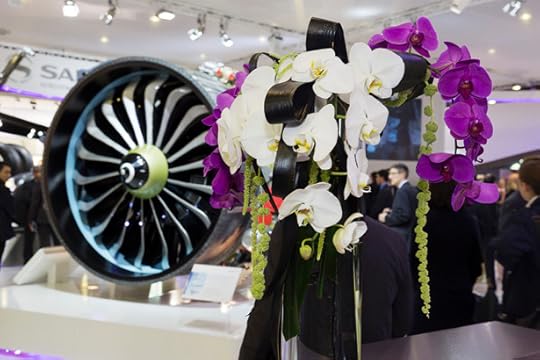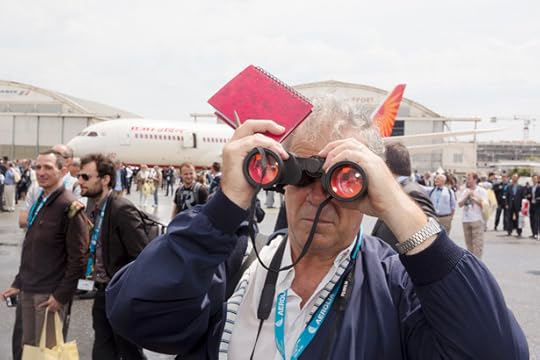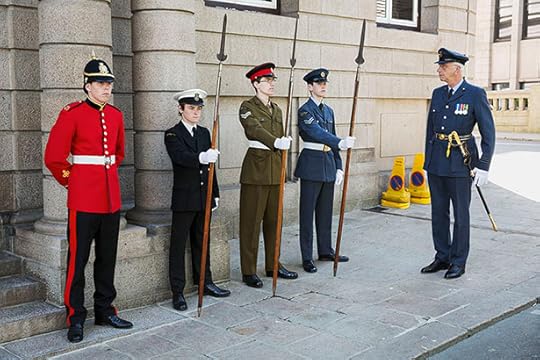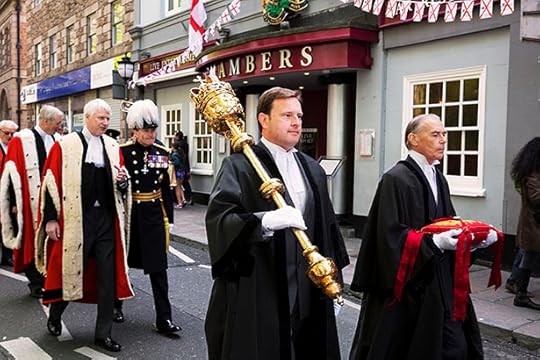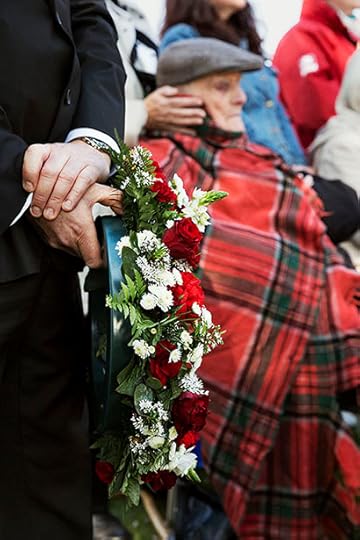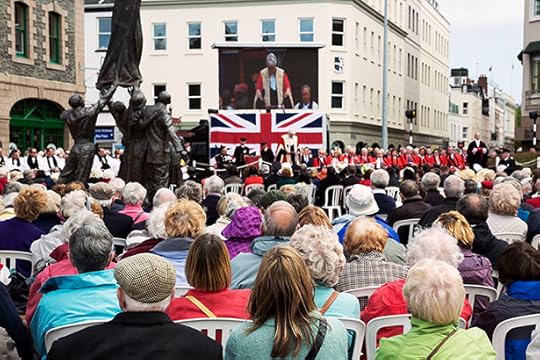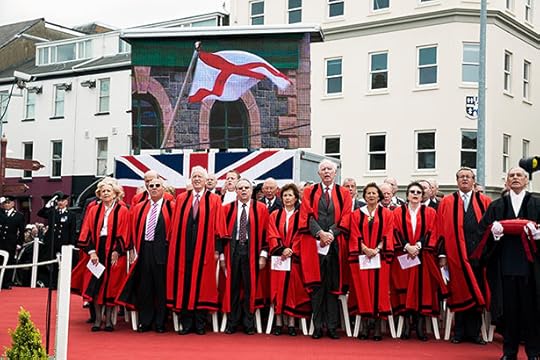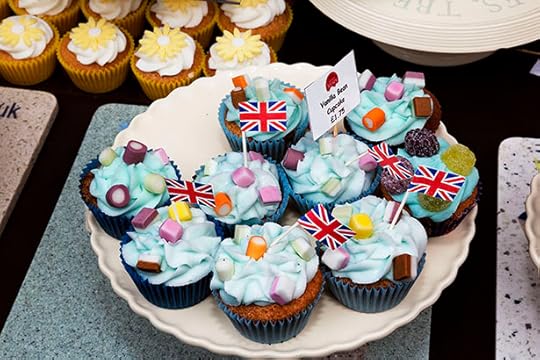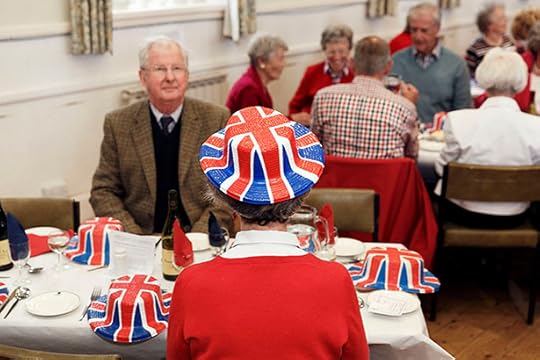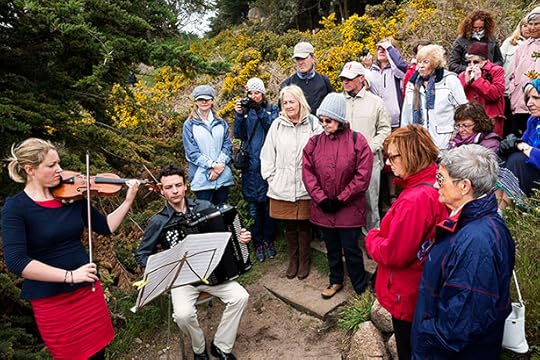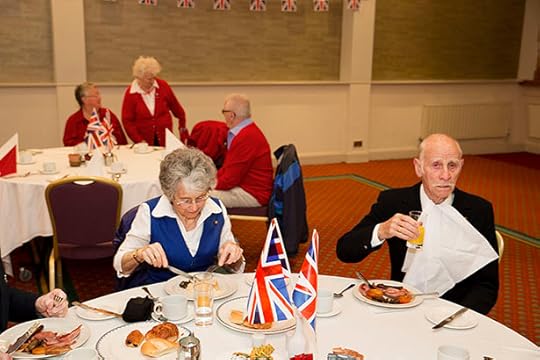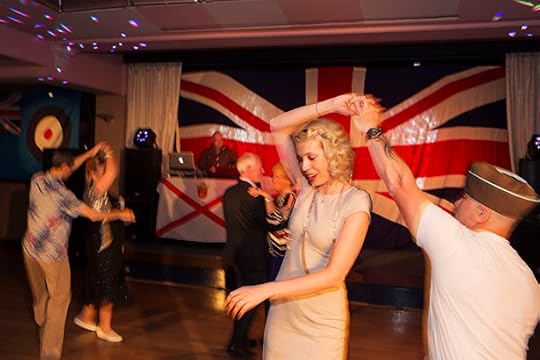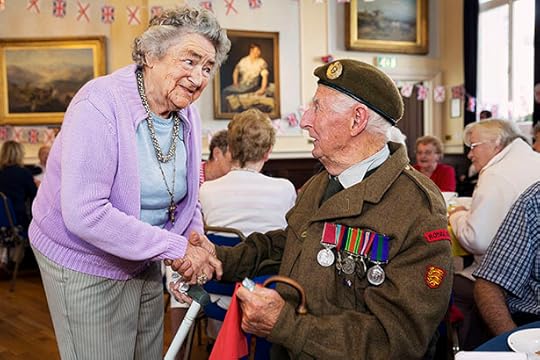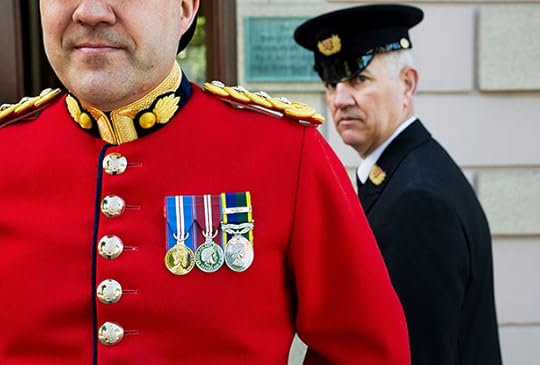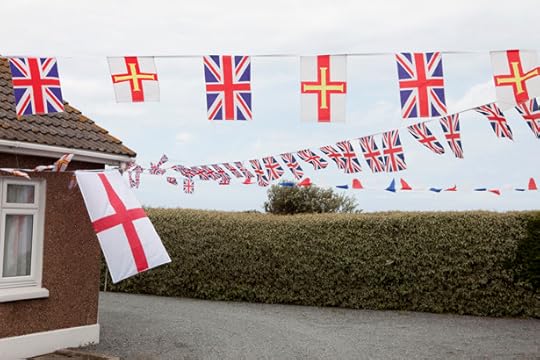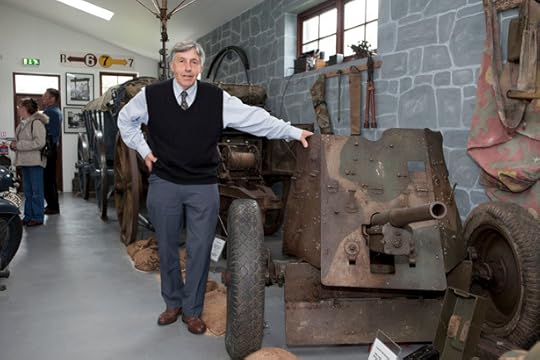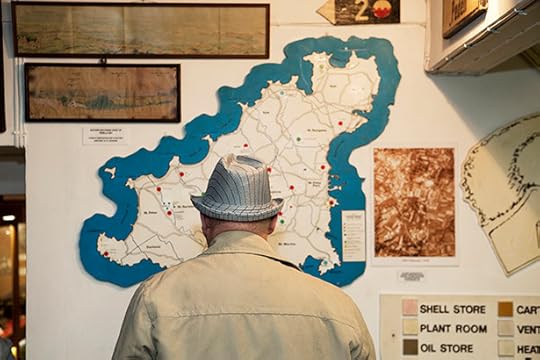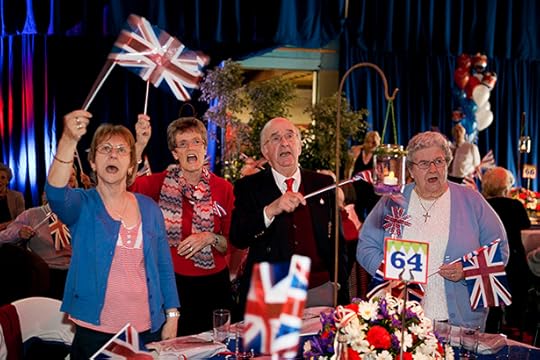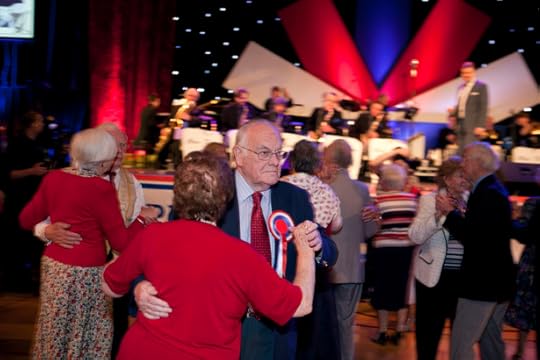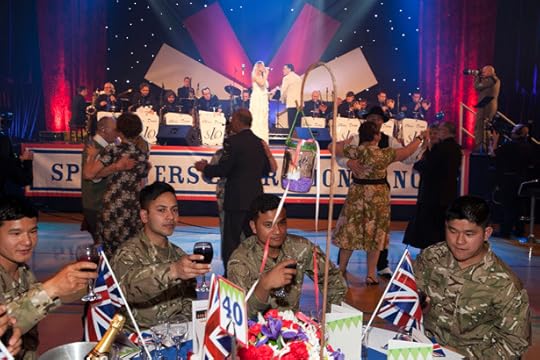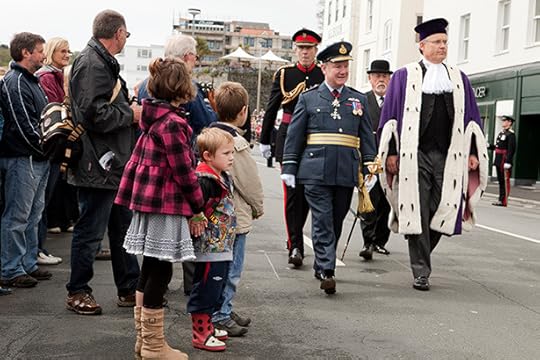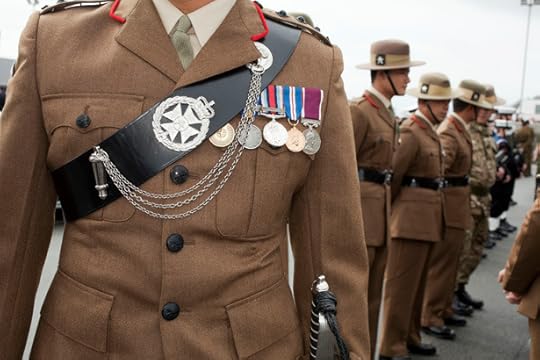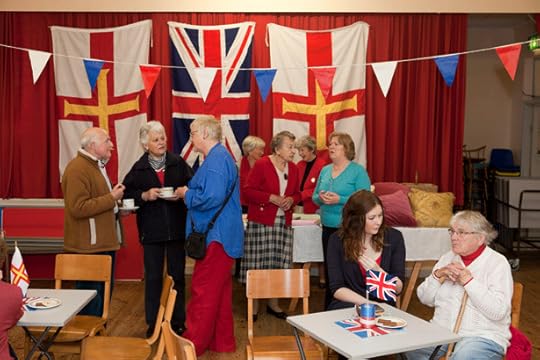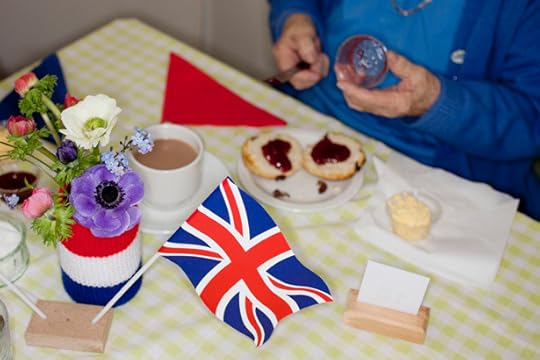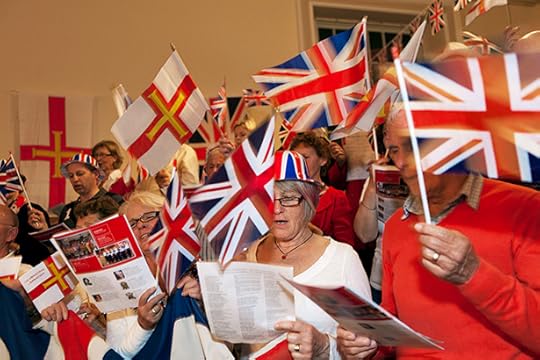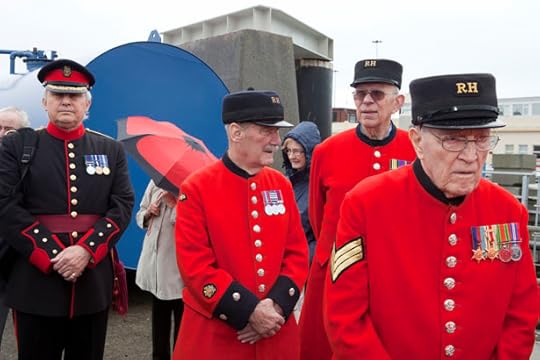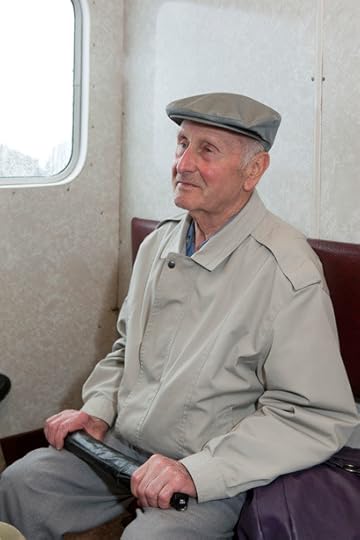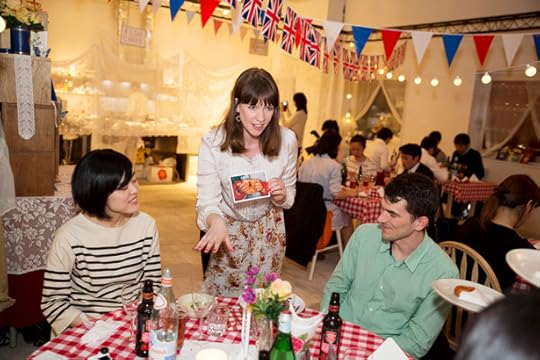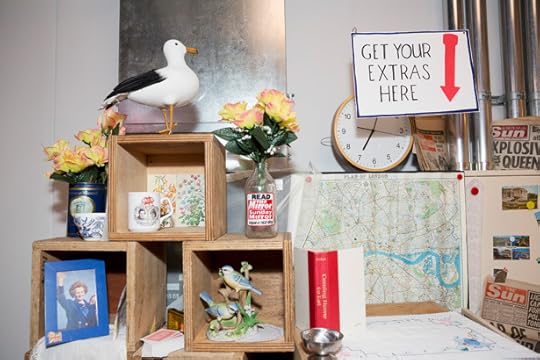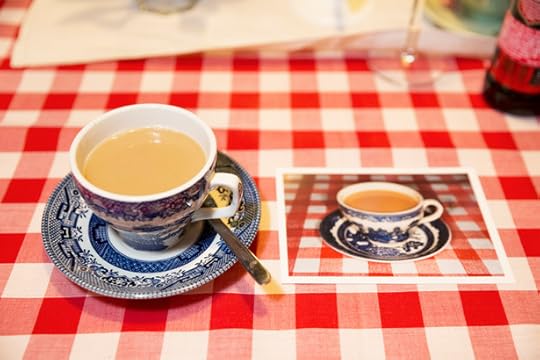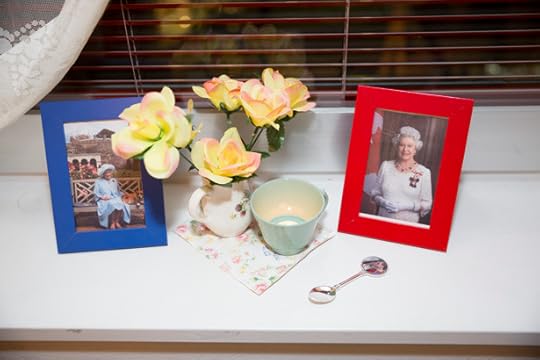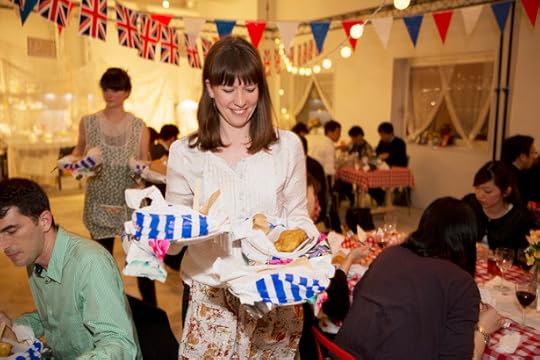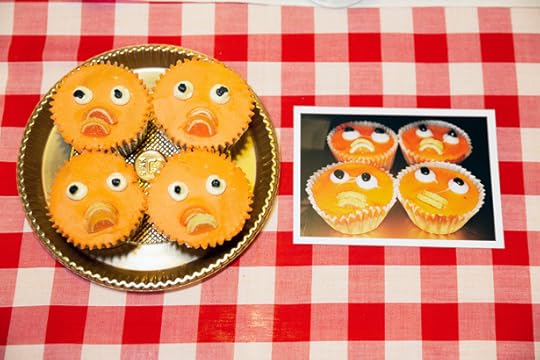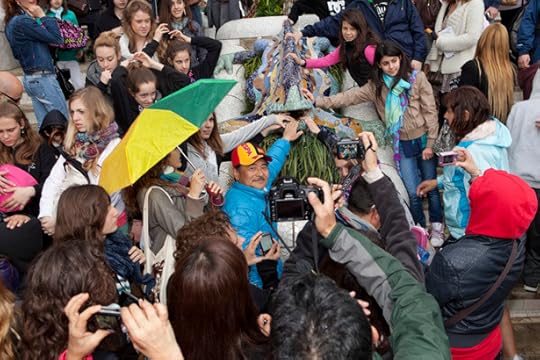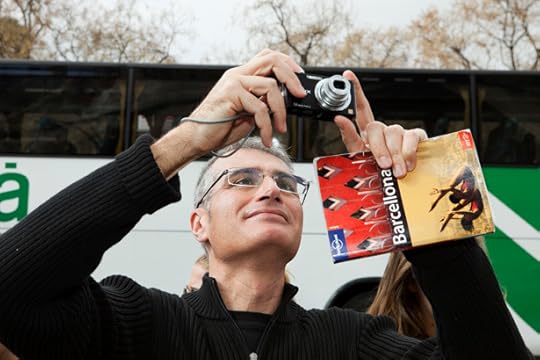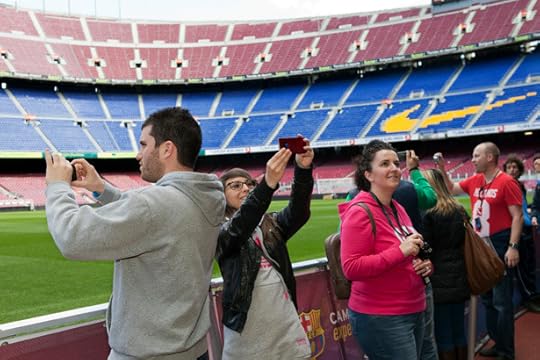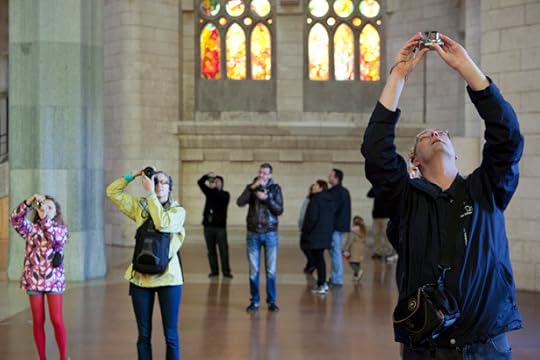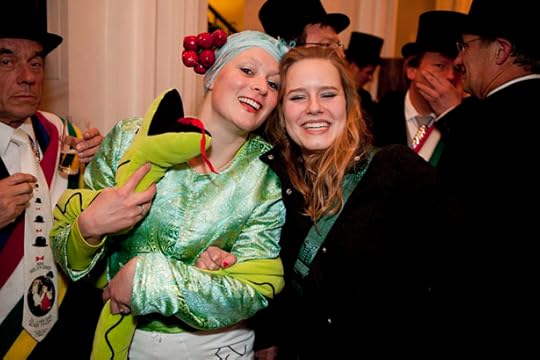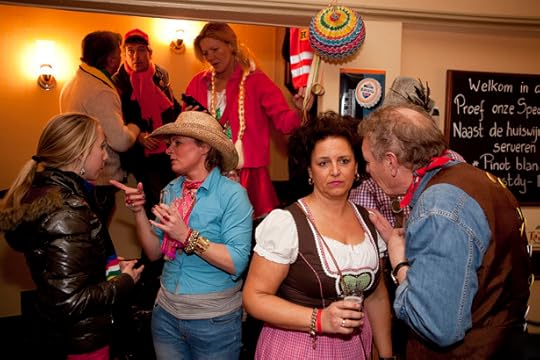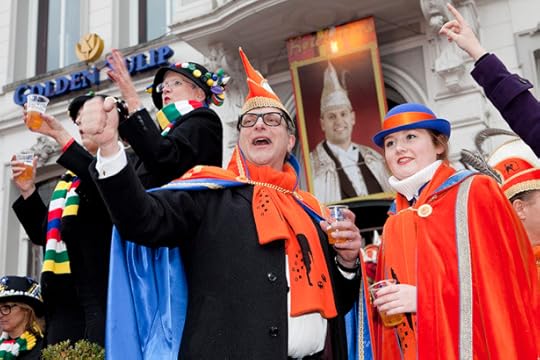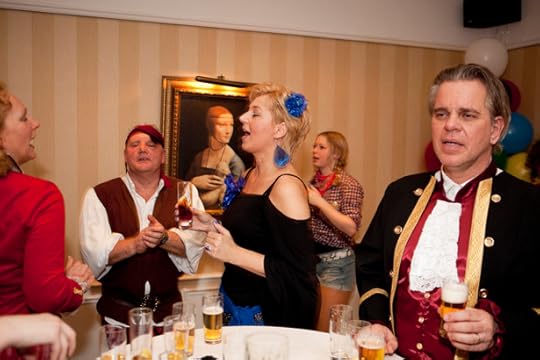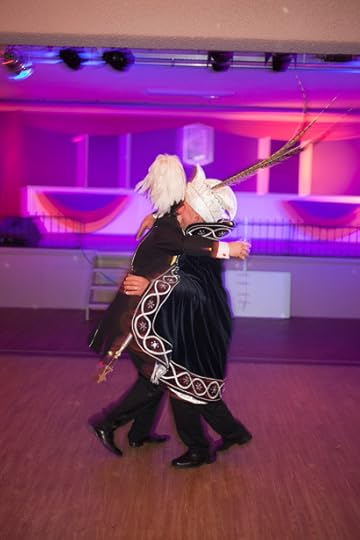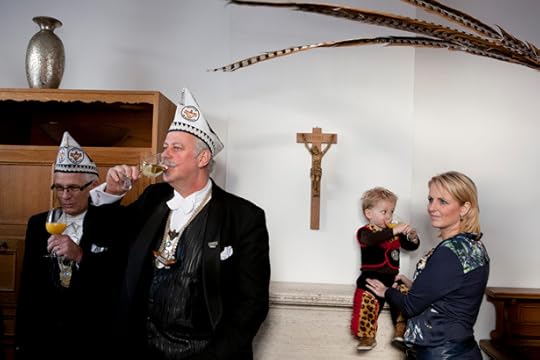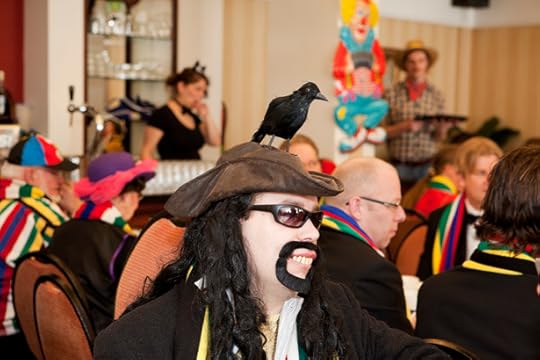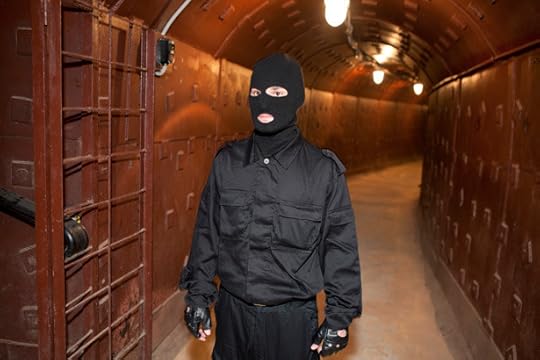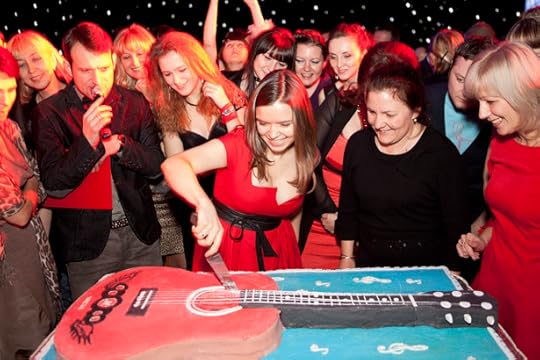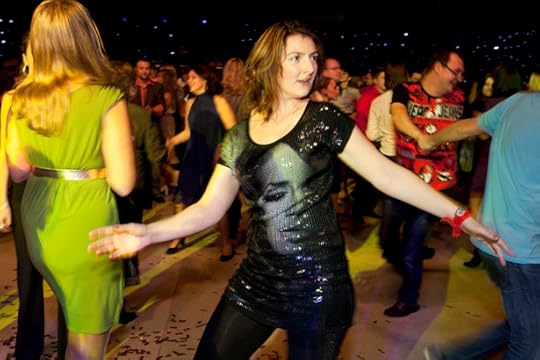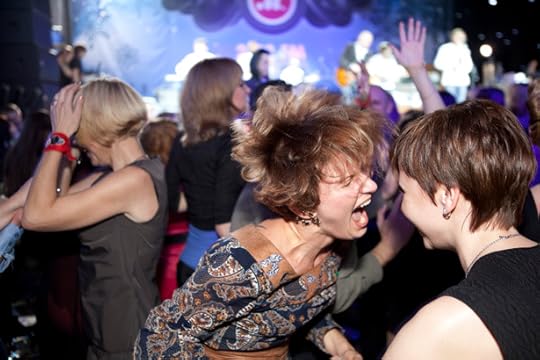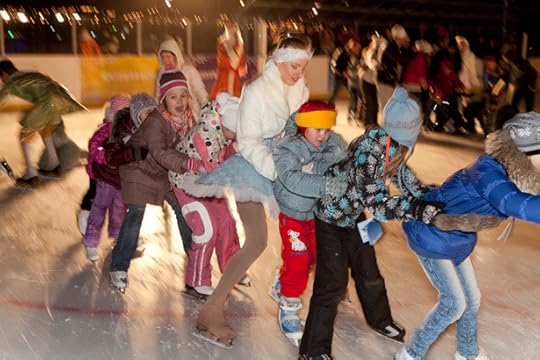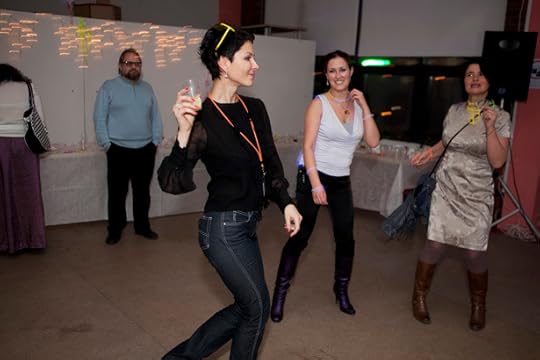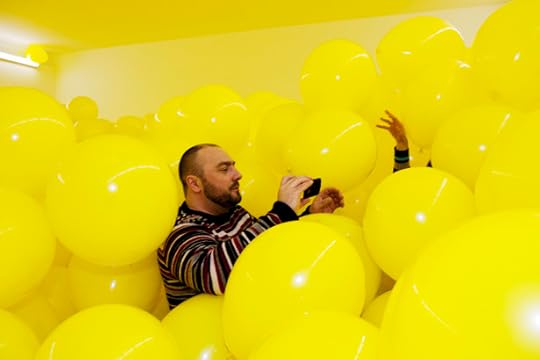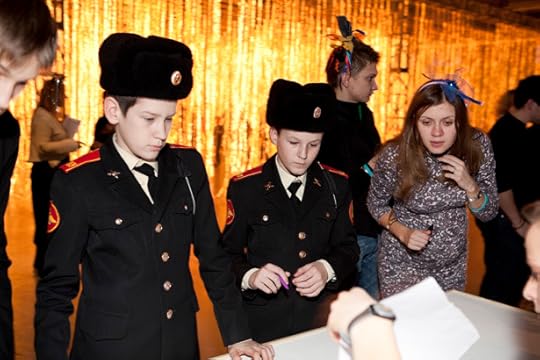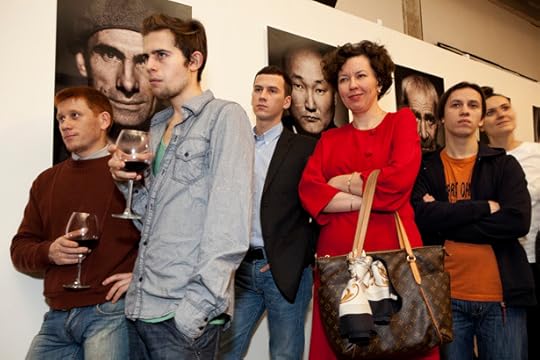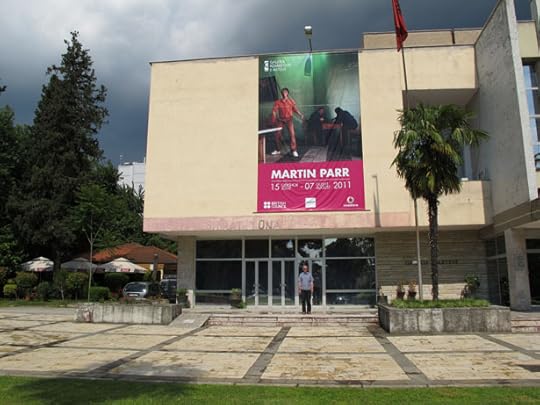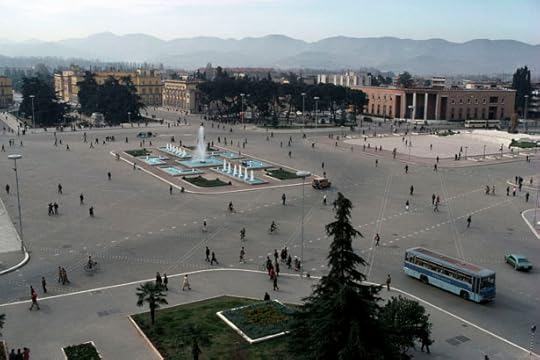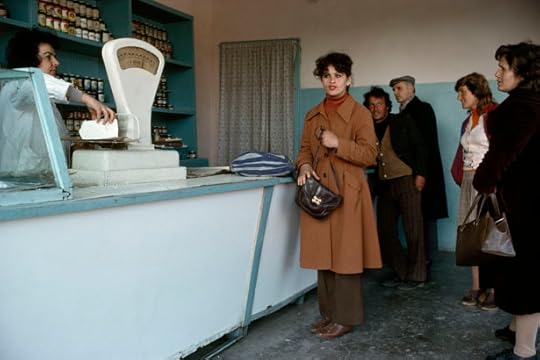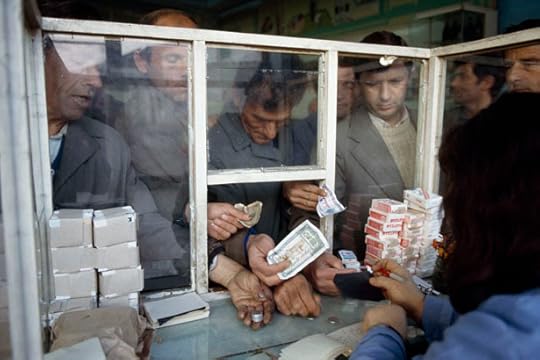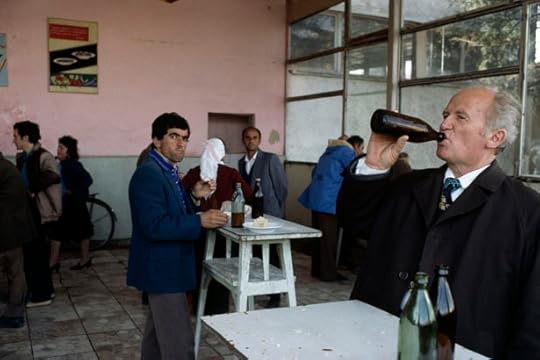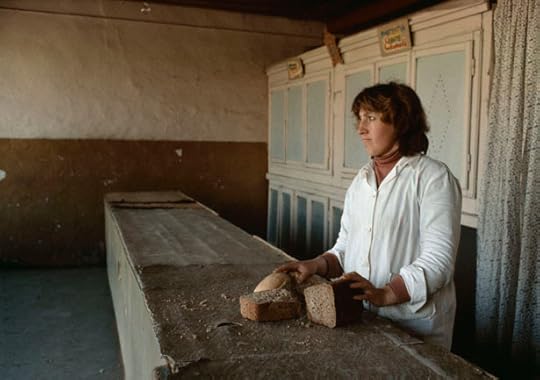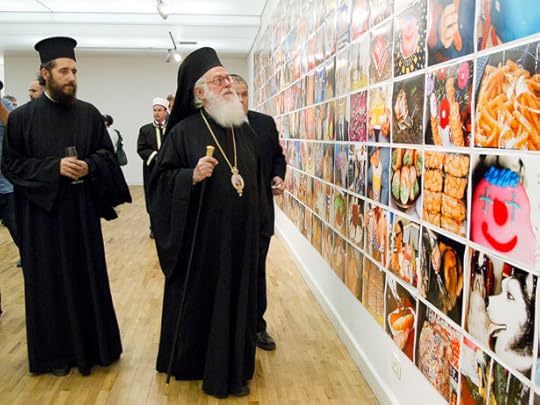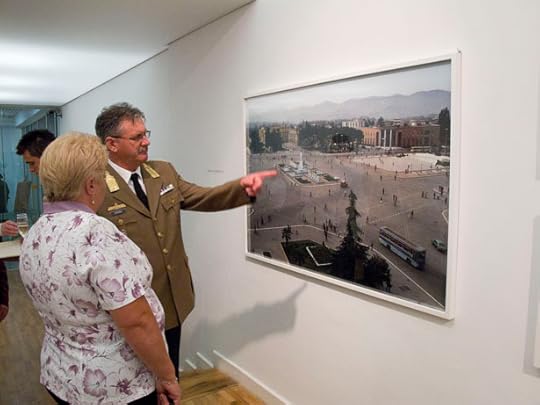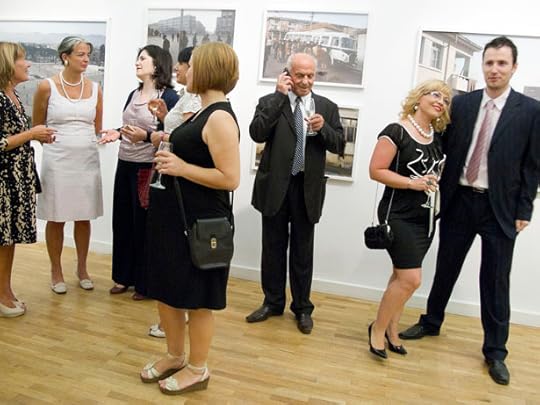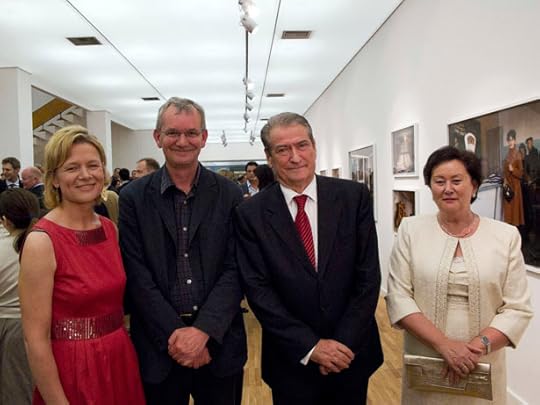Martin Parr's Blog, page 3
August 6, 2013
Paris Air Show
Paris Air Show

Getting to the Paris Air Show is not easy. The RER from Paris Centre that was meant to stop at Le Bourget glides past the station and stops at Aulnay, where hundreds of suited delegates have to cross the platform to get a train back. This mishap is typical of RER, whose trains seem constantly to have problems. It even makes me appreciate South West Trains. By the time we arrive it is pissing down and a huge queue has accumulated for the shuttle to the vast hangers of the show.
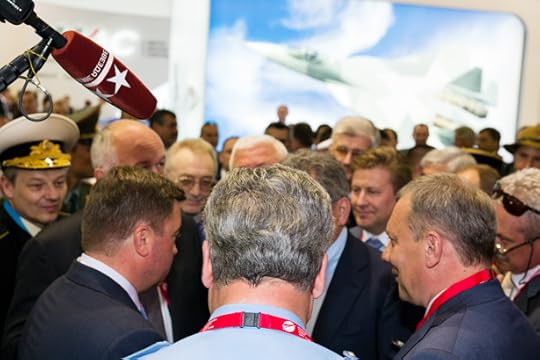

The show ground is vast and it is remarkable to speculate how many thousands of sales people and visitors are involved in the airline industry. Being Paris Air Show, I was expecting lots of nice planes from the likes of Airbus and Boeing, but I soon learn the defence companies, now known as ‘security’, form the biggest part of the show.
Companies like MBDA, who sell missile systems -bombs to you and me – have a vast display with an impressive graphics backdrop that changes and evolves over a 3 minute cycle. A team of 20 salespeople hover with their clipboards, ready to pounce when any interest is expressed by the visitors.
Touring round the displays I soon notice the flowers. Virtually every stand has floral arrangements, and the more destructive or offbeat the contents of the stand, the more elaborate the display. The florists of Paris must have had a good week.
From time to time I bump into assorted military personnel doing the rounds. Russians and Chinese get everybody excited as they have money to spend. But when I meet the Minister of Defence from Burkina Faso looking at a helicopter he confesses he has no cash, but just wanted to see what the big boys spend their budgets on. At the other end of the scale the Russian Defence Minister has a huge entourage. This includes attachés, press and assorted hangers on, keenly awaiting his every utterance.
By noon the rain has ceased and planes are starting to fly and perform and now we can get down to the real business of watching and marvelling at the latest aircraft, with a few vintage ones thrown in. There seems to be quite a lot of plane spotters in attendance, which is a surprise given the professional clientele, but it seems that for 37 euros you can get access before the show opens to the public.
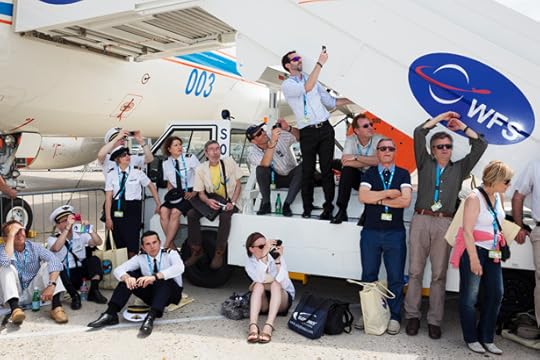
Of course people looking up into the sky, normally with a camera, is a nice gift for me, but it is easy to forget that the crowd here really love aeroplanes in a way I can never really appreciate. When a new fighter jet swoops by upside down there is a chorus of ‘oohs’ and ‘aahs’.
One thing is also clear; there is a huge amount of hospitality going on. The site is riddled with electric vehicles, all sponsored by different companies, rushing assorted suited men and generals from many countries to the latest meal, with wine, which is provided in the chalets overlooking the runway. This, it seems, is the way to sell planes.
By the end of the show both Airbus and Boeing announce new sales north of $60 Billion. This is a very big business indeed.
May 26, 2013
Liberation Day, Jersey 2013
Liberation Day, Jersey 2013
Text by Susie Parr
Away from St Helier, you might not realise that May 9th is a special day in the Jersey calendar. Unlike Guernsey, where flags flutter from virtually every house, tree and telegraph pole across the island, Jersey seems to take a more low key approach. In some of the quieter and more remote settlements, aside from the occasional bed of strategically planted red and white geraniums, there is little to indicate the significance of the date.
But flags play a very important part in the Jersey Liberation Day celebrations. On May 9th 1945, at 7.18am, British soldiers disembarked from HMS Beagle and went to the St Helier Harbourmaster’s Office and the Pomme d’Or Hotel – facing the harbour – where they ran up the Union Jack and Jersey flags. Every year, this symbolic event is re-enacted, to great cheers from the crowd in Liberation Square. The re-enactment follows the formal service in which speeches are made, hymns sung and prayers intoned by ministers of the church and state, all kitted out in full ceremonial regalia.
Around the square various stalls offer sea food, spit roast pork, ice cream, cup-cakes, burgers, pancakes and Jersey Wonders – sweet and sticky cakes a bit like doughnuts. You can also buy wartime fare – like corned beef hash – from vendors dressed in 1940s outfits. Wine, beer and cider flow. Such abundance makes the address given to the States of Jersey by John Gallichan, Connetable (or Mayor) of Trinity, relayed to the large screen on the square, all the more poignant. John was 21 months old on Liberation Day and he talks movingly of the privations his family experienced. Things got worse as the war neared its end, with the Germans exporting the bulk of local produce and cattle to feed their troops, leaving the islanders at starvation point. John describes tea made from powdered sugar beet, parsnip coffee and the family’s elation when the precious Red Cross parcels started to arrive.
Back on John’s home patch, in Trinity’s flag-bedecked parish hall, the feasting continues with a Liberation Day supper. Ninety six people have each paid £12 to attend, with profits going to the Red Cross. The supper is prepared by ladies of the parish, who bustle about in crisp white aprons. Events unfold with military precision. Bowls brimming with peas and Jersey Royal potatoes are placed in five hostess trolleys that warm the plates and platters ready for the arrival of the roast chickens. On cue, the ladies emerge from the kitchen with tureens of steaming vegetable soup for each table. As the diners enjoy the first course, home made rhubarb tarts –which will be served with thick Jersey cream – are lined up to cool on a nearby table.
After the meal, John thanks the cooks and leads a sing song, shouting out numbers from the parish song book. This is also a brisk, no nonsense affair, just one verse from each of the old favourites – Pack up your Troubles, Daisy Daisy, There’ll be Blue Birds. The swift transition between songs is accomplished smoothly thanks to the excellent pianist who moves from key to key, and melody to melody, with ease. The event reaches a Last Night of the Proms-like climax in a hearty rendition of Rule Brittannia and There’ll always be an England, accompanied by much waving of Union Jack hats. The church clock strikes 10 and the diners emerge from the brightly lit hall into the dusk, as pipistrelle bats flicker around the windows.
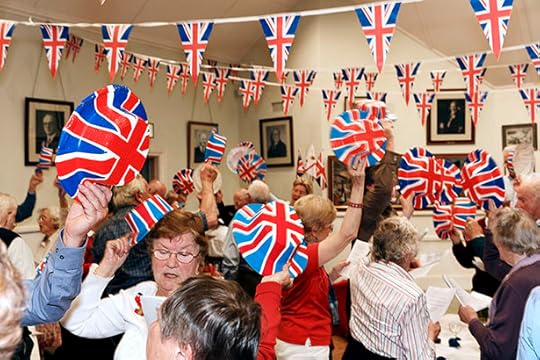
The imaginative events organized by Jamie Walton for the International Music Festival appeal to a broader spectrum of music lovers. A musical walk along the rugged coastal path above St Brelade’s Bay attracts a good crowd, most with waterproofs zipped up against the strengthening south westerly. Bearing a chair and stand with sheet music attached by clothes pegs, Jamie goes ahead, trying to find sheltered spots where the violinist and accordion player can perform without having their music lost to the wind or their fingers seizing up in the cold.
Challenging in a different way, another novel musical event is held in the old German Command Bunker at Noirmont. Leaving the sunshine, the audience files down into a chilly, echoing, underground chamber. Virtuoso musicians Michael Collins (clarinet), Boris Brovstyn (violin) and Michael McHale (piano) perform Poulenc’s Clarinet Sonata and A Soldier’s Tale by Stravinsky. Intricate works based on The Soldier’s Tale, by two young composers from the Jersey Academy of Music, are given the same serious attention by the musicians as the classic pieces. Both young people seem delighted and rather awed by their reception. The youngest’s blazer and school tie suggest he has been allowed to miss double maths for this special occasion.
Readings by local authors are interspersed amongst the different sections of the Stravinsky. 90 year old Eric Walker, one of the Tommies who helped to clear mines from the newly liberated Channel Islands, reads a poem about a mine clearance soldier, Sapper Onions, who died on Alderney:
‘Here buried lies
the shattered corpse of but a boy,
who gave his life to make your land safe.’
Soldiers like Eric were overwhelmed by the rapturous welcome they were given as they arrived in Jersey back in 1945. Although the number of people who experienced and can remember the Liberation is in inevitable decline, it has been marked every year since with dances, concerts, meals and parties across the island. Perhaps the most sombre event, fittingly held at the crematorium, is the memorial service commemorating the hundreds of forced workers brought into Jersey by the Germans to build fortifications. Tellingly, only one survives: Emile Boydens, a Belgian, who still lives on the island.
And it seems fitting that, in many of Jersey’s celebrations, food takes centre stage. A splendid Liberation breakfast of bacon, eggs, beans, tomatoes, coffee, orange juice and toast is held for fifty people at the Royal Hotel in St Helier, beginning at 7.18 am exactly. For Leo Harris, the breakfast organizer, Liberation actually began on May the 8th. He was living in an area that was always thronged with Germans, but on that day he remembers looking up and down the street, astonished that they had all disappeared. He points out a frail-looking elderly lady, who sits chatting with friends. ‘She was one of the prettiest girls on the island. A blonde, and she was always being whistled at by the Germans. They would come up to her at the Havre des Pas lido and she would toss her mane as if to say ‘No chance!’’
But, although islanders are reticent about this, plenty of people did cooperate with the invaders. One estimate is that 900 children were fathered by Germans on Jersey. It is said that those women who went with German men were punished and shunned once the war came to an end. It follows that there must be people living on Jersey who have mixed feelings about Liberation Day.
One breakfaster proudly points to his lapel: all school children on Jersey were given a medal to commemorate the Liberation. Every year since 1945, at 11am on Liberation Day, he stands on the same spot on Conway Street to watch the bands, troops and dignitaries march past. This is exactly where he stood 68 years ago, when soldiers threw chocolate into the crowd, to the delight of the hungry children.
Text: Susie Parr
Photographs: Martin Parr
Liberation Day, Guernsey 2012
Liberation Day, May 2012
Text by Susie Parr
Spring has come to Guernsey. Recent downpours have given the earth a thorough, much needed soaking. A watery sun emerges and starts to warm away the chill of the past few days. Clumps of Erigeron daisies burst from the high grey stone walls that line St Peter Port’s narrow lanes. Out of town, the hedgerows are vibrant with ragged robin, bluebell, allium, dandelion, primrose and celandine. By the side of the road, the ‘hedge veg’ stalls display free-range eggs, punnets of early strawberries and bags of small new potatoes, still crusted with soil.
Driving through such peaceful scenes today, it is hard to imagine the strife, suffering and near-starvation experienced by islanders during the German occupation, an ordeal that lasted from June 1940 to May 1945. A visit to the German Occupation Museum tells the story through a series of exhibits, meticulously curated by Richard Heaume – a farmer born during the war – whose passion for collecting and cataloguing the things the Germans left behind led him to open the museum on a not-for-profit basis in May 1966.
As befits its military focus, the museum displays arms, engine parts and weapons, field equipment, medical instruments, uniforms and helmets. But the poignant social history of the occupation quietly takes centre stage. One vitrine displays the small, battered, blue leather suitcase belonging to Rachel Rabey, one of the many Guernsey children evacuated to mainland Britain just before the invaders arrived. Children like Rachel stayed away from their families for five years. Rachel’s name is written in wobbly, inky letters across the inner lining of the case that contains her vest, knickers, and white shirt, carefully folded, together with a pair of fawn, hand-knitted socks. The small, dark haired girl stares out sadly from a black and white photo that is placed next to her blue gym slip, pullover and moth-eaten school scarf.
A visiting group of local school children is ushered through the museum by two teachers. They contemplate Rachel’s suitcase and talk about what it must have been like to be a five-year-old evacuee. They drift past the displays of military hardware and come to a halt by the display of the foodstuffs that the starving islanders had to resort to, particularly in the last few months of the occupation, after Allied forces had invaded France and supplies to the island ran catastrophically low. Here you can see jars of sugar beet syrup, bramble tea, parsnip coffee, carrageen moss and potato flour. The children read how cats, dogs and rabbits were eaten. The teacher with them says: ‘To this day my mother will not eat parsnips as it reminds her of the war. She used to live on parsnips and seaweed. They used acorns to make coffee you know.’ The children contemplate the toys and cooking pots that resourceful islanders made out of empty tin cans and think about an island life very different from their own.
These domestic artefacts have a chilling counterpart in the displays of German dining ware: a silver coffee pot and a fine linen napkin printed with swastikas suggest the relative power and privilege of the invaders. The brutality of the occupation is conveyed in a small, understated room that details the grim lot of Guernsey Jews and the privations of the thousands of slave workers transported to build extensive fortifications and housed in appalling conditions in island work camps. And it was not just the slave workers who suffered. Throughout the museum, posters and proclamations indicate the ruthless response to any acts of resistance by islanders. Louisa Gould sheltered a Russian escapee and was sent to the gas chambers. Winifred Green was sentenced for 6 months in jail for telling the chef at the Royal Hotel: ‘to hell with Hitler for a rice pudding.’ Louis Berrier was charged with having released a pigeon with a message for England. The proclamation continues: ‘He was therefore sentenced to death for espionage and SHOT on 2cnd August 1941.’
Many islanders were betrayed by local informers. The Germans offered rewards for any information about acts of resistance, such as marking stones and walls with the V sign. Anonymous letters from informants make disturbing reading. Written in pencil, in shaky capital letters one starts: ‘G BUCKINGHAM HAS LARGE STOCKS OF STOLEN GOODS, NEW ENGINES, DIESEL, PETROL, OILS, PAINTS…’ And those who were perceived to be collaborating with the enemy were ostracized. The island communities must have been riven with suspicion and mistrust.
More disturbing reading comes in the form of the Guernsey Evening Press, which continued to be published throughout the occupation and was used by the Germans as a medium of communication and control. On the 29th June 1940, the day before the occupying troops arrived, the headlines deplore the ‘dreadful toll of German bombs and machine guns’. Twenty two people had died in the bombardment of St Peter Port. On Monday July 1st the front page of the Press was given over to a set of instructions from the commander of German forces in occupation which begins:
‘1) All inhabitants must be indoors by 11pm and must not leave their homes before 6am.
2) We will respect the population of Guernsey but should anyone attempt to cause the least problem, serious measures will be taken and the town will be bombed.’
On both days, the front pages carried advertisements for Fison’s fish fertilizer and the Home Circle Library, as if life was going on as normal when in fact everything had changed. Five long years later, the edition of the Press published on May 10th 1945 conveys a sense of the atmosphere in St Peter Port as the island was freed:
‘There were indescribable scenes of intense joy and excitement. Never to be forgotten. After 5 weary years Guernsey was really free. The Tommies arrived and for the first time since June 1940 carefree and gay laughter was heard. The whole town was painted red white and blue. Church bells pealed forth their joyous tidings.’
Sixty seven years on, Guernsey continues to mark Liberation Day with processions, parades and cavalcades, church services, concerts, fairs, fireworks and special events. Public buildings, shop windows and private houses are festooned with red white and blue bunting, Union Jacks and the Guernsey flag. Pubs serve Liberation Ale and restaurants offer special Liberation Day menus. Specsavers, the multi million pound company established in Guernsey in 1984, is a primary funder of two major events: an afternoon tea dance for islanders who lived through the occupation or were evacuated or deported, and a ball in the evening that is open to all.
At the tea dance, no expense has been spared to create an atmosphere of celebration and plenty. The walls of the enormous hall at the local leisure centre are hung in red, white and blue and display huge blow ups of classic wartime posters urging ‘Dig for Victory’ and ‘Keep Mum, she’s not so Dumb’. Some 70 round tables, each seating twelve guests, fill the vast space. The tables are densely decorated with flags and flowers and laden with sandwiches, scones and Guernsey gache (a kind of fruit bread) thickly spread with yellow butter. Waitresses serve tea and coffee while the 15 piece Syd Lawrence Orchestra plays wartime big band favourites. Singers croon ‘Dancing cheek to cheek’ and ‘You do something to me’. Images of the musicians are projected in black and white on four big screens around the hall.
Those guests who are still able to do so take to the dance floor. Everyone joins in with the sing songs. Helpers and organisers hover around the edges of the hall, some dressed in 1940s uniforms and outfits. Dame Mary Perkins (the founder of Specsavers) wears a Union Jack shift dress, shiny with sequins. In her welcome to the tea dance guests, Dame Mary thanks everyone present who is wearing Specsaver glasses and hearing aids. Although she seems to be speaking in jest, she has a point. The place is crammed with people in their 70s, 80s and 90s. Glancing round the hall there is clear evidence that women live longer than men: at each table the men are heavily outnumbered. But everyone is having a good time, chatting, eating and singing along with the band.
The Hangar Ball takes place in the same venue that evening. The same compere, musicians and entertainers are present but the tea, sandwiches and scones are replaced with alcohol, stew and baked potatoes. And the joint is jumping. Although tickets cost £30, the ball is a sellout- more than 800 people, old and young, arrive to enjoy the fun. While there are still a few Union Jack hats, frocks and waistcoats in evidence, most have taken great care with their dress: women wear red lipstick, hats, seamed stockings and neat army uniforms or authentic 40s evening dresses with fox fur stoles. Evacuees, air raid wardens, French resistance fighters, Tommies, sailors, spivs, red cross nurses and GIs mingle around the tables. One person appears dressed as a ration book, which makes negotiating the crowded dance floor something of a challenge. A group of young women dressed as land-girls, in dungarees and headscarves, wheel their barrow full of vegetables up to the stage to receive the prize for the best-dressed table: a meal for 11 at a local restaurant. The best dressed couple (this year a French policeman wheeling a vintage bicycle accompanied by Helga, glamorous in blonde wig and German uniform) win a trip to St Malo. The vibrant atmosphere and the effort and care that everyone has put into their outfits suggest that the Guernsey Hangar Ball must be one of the most authentic and keenly felt retro events to be staged anywhere in the British Isles.
Liberation Day, the 9th May, gets off to a damp start but soon the sky behind the rocky islets lying off St Peter Port is streaked with pale, watery blue. The day involves much ceremony and pageantry. Soldiers, veterans and a group of visiting Ghurkas march along the front, led by the Guernsey Concert Band. The troops are inspected by the Lieutenant-Governor of Guernsey and the Bailiff, both decked out in their ceremonial robes. A group of Chelsea Pensioners marches along to join the parade, clapped by the crowd. People wave flags from the yachts and cruisers berthed in the harbour. The church bells peal out, just as they did 67 years ago. Quietly watching all this – although not actually taking part -John Greenfield is the only member of the original liberating force who has been able to come to the island this year. The remaining few others are not well. John has returned to Guernsey every year since the war. He was 18 when he arrived in St Peter Port with Task Force 135 to be greeted by ‘cheering, weeping, delirious islanders who gave these men of the British Army a welcome such as has never been equalled’ (Guernsey Evening Press). John says that it was touch and go whether he would be able to come this year, as his own health is not so good.
Away from crowds and bustle of St Peter Port, the ladies of St Matthews in Cobo are busy serving tea, coffee and biscuits in the church hall. The parishioners decided to put on a coffee morning after Cobo’s own liberation ceremony, in which the Guernsey flag is planted on the Grosse Rock, a mile off shore. Stand on Cobo’s beautiful white sand beach and you can clearly see the rock with the red, white and yellow flag streaming out in the strengthening south wind. Inside the church hall, there is quite a crowd and much chatter and laughter. Each table is decorated with a Union Jack flag, set in a jam jar wrapped in red, white and blue ribbons. Around the hall, a few stalls display raffle items, hand knitted blankets and jumpers, home made cakes and strawberry tartlets, foil-wrapped chocolate teacakes, second hand jigsaw puzzles and jewelry and red white and blue woolen pom poms. A hand written sign reads: ‘Celebrate: wear a pom pom.’
Ruth Duquemin is helping to run the cake stall, putting the takings into a battered metal cash box. Ruth is 92 and remembers the occupation: ‘It was terrible, particularly when we ran out of food. It got a bit better when the Red Cross parcels came, but things were very hard. It was a great day when we were liberated. I walked to town with my mother and sister to see what was happening. I couldn’t believe the number of Union Jack flags that appeared. People must have been hiding them away.’
Back in St Peter Port, as evening draws in and pubs and restaurants bulge with merry makers, the Queen’s Diamond Jubilee and Liberation Concert gets going. Ticket holders have been encouraged to attend the last night of the Proms style event ‘in party spirit with red white and blue flags, bunting, whistles and hats’ and the atmosphere is thick with patriotism. At 10 pm, fireworks arc into the rain to mark the end of the day.
But away from all the razamatazz and flag waving, some quieter stories are unfolding. On May 10th Richard Heaume boards a ferry in the company of the troop of Chelsea Pensioners and the band of Gurkhas – some looking rather queasy as the boat hits rough seas – heading for the small, rocky island of Sark to mark its own liberation day. Sark’s ceremony is short, understated and poignant. Lone piper Bill Jenkins plays a lament over the grave of four-year old Nanette Hamon, who died during the occupation when she stepped on a landmine.
Doris and Walter Theuerkauf, accompanied by two of their daughters, travel with Richard on the boat. Doris’s father – Heinz Herdt – served as the Commandant of Sark during the occupation. Doris says her father never spoke of his wartime activities to anybody in the family, including her mother. It was only after his death in 1977 that she unearthed documents, letters and photographs and discovered that he had served on the island. She understands that Heinz was liked and respected by Sark people as he was a great horseman and, coming from farming stock himself, sympathetic to the plight and problems faced by the farmers. Intrigued to know more about this secret history, Doris first visited Guernsey in 1987 and got talking to Richard at the museum. They became friends and she has donated many items from her father’s archive to Richard’s collection.
Doris and her family have been back to the Channel Islands several times: ‘My generation was so ashamed. Everybody was guilty. We come back to make friends and to show that Germans change. Everybody is open to us. We are no longer the enemies. It makes my life more interesting. Every year I come back I learn a little bit more.’
Travelling on the ferry with the Theuerkauf family is 87 year old Fritz Kunz. At the age of 17, Fritz was put in charge of signaling systems on Guernsey. Today at AJs café, half way down Sark’s main thoroughfare, Fritz greets an old friend – Werner Rang – who worked as a medical orderly on the island during the occupation. Post war, after Werner had served three years as a prisoner of war, he married his Sark sweetheart, Phyllis Baker, whom he met on the island in 1943 when she was suffering from tonsillitis. The couple have lived on Sark since 1949.
For Richard Heaume, his friendship with Werner and the German visitors is one step in the long process of healing and reconciliation. For years after the war, many Channel Islanders simply did not talk about what had happened. Like Doris’s father, they built a wall of silence around the occupation. Everyone wanted to forget, to wipe out the fear, misery and shame of those years. But the people of Guernsey and the other islands now understand that the occupation is a hugely important part of their history:
‘We’ve turned a full circle. Twenty years ago we wouldn’t have thought of restoring the fortification sites on the islands because of the sensitivity. But now it’s history. Many Germans were also liberated in 1945. Not every one was a Nazi. We have reached reconciliation with our German friends. One has to accept and move on.’
Richard’s words accord with the sentiments expressed in a short, hand written note left for the islanders by the departing troops, framed and displayed in his museum:
‘The Germans wish you all on Guernsey a happy future and hope to see you again under peaceful circumstances. Farewell and cheerio. May 10th, 1945’.
May 1, 2013
Pop Up Magic
Pop Up Magic
Our daughter Ellen Parr – a chef - runs a company called The Art of Dining with artist and set designer Alice Hodge. They put on theme-based pop up restaurants, normally in London. Alice designs the environment and the set and Ellen creates an appropriate menu. The venues – always unusual and unexpected – have included a 16th century mansion, an eel and pie shop, the Victorian Dalston Boys Club, and the army barracks on City Road. The themes range from wartime rationing to the Food of Love. The whole experience is like eating within an interactive art installation.
A while back Ellen and Alice suggested that they try and create a meal based on my food photography. Quite a challenge as it is one of the features of my work that food is shown as you find it for real, rather than the alluring perfection normally displayed in adverts.
So six months later, I am in Tokyo and four nights of ‘Say Cheese – the photography of Martin Parr in five courses’ have just finished. On the seventh floor of an office building, you enter a typical English café setting with gingham table cloths, plastic flowers on the table, pictures of Lady Di and Mrs T, copies of the Sun and other very British items adorning the surroundings. The waiting staff are mostly English, wearing floral pinnies, and the five courses are all based on different Parr photos. But there is a twist: the food looks just like the images but tastes completely unlike what you expect. An English tea cup is filled with a tea coloured liquid, poured from a tea pot, which turns out to be a delicious Thai broth. A doughnut is actually savoury, made from lentils and served with a coconut chutney. Fish and chips are served in a Tesco bag. Lurid orange fairy cakes turn out to be moist carrot cakes served with a fragrant chai. Each course is introduced by Alice, holding up a postcard of the image. The diners take away a signed set of MP postcards showing the meal they have just eaten.
With the help of producer and entrepreneur Ivan Vatarin (fortuitously a fluent Japanese speaker) the girls managed to source the ingredients – including cod from the famous Tokyo fish market – and the four nights of the pop up sold out with Ivan’s extensive network.. Pop up restaurants are not known in Japan, so this was a difficult concept to grasp at first. But the excitement and challenge of a kind of greasy spoon theme park attracted people from across Tokyo. The food was relished and seemed to cause delight and amusement amongst the customers.
Short Film:
Say Cheese: The World of Martin Parr in Five Courses
Look out for this event to be rolled out in other cities, with London as the next candidate.
http://www.theartofdining.co.uk/
February 26, 2013
Liberation Day, May 2012
Liberation Day, May 2012
Text by Susie Parr
Spring has come to Guernsey. Recent downpours have given the earth a thorough, much needed soaking. A watery sun emerges and starts to warm away the chill of the past few days. Clumps of Erigeron daisies burst from the high grey stone walls that line St Peter Port’s narrow lanes. Out of town, the hedgerows are vibrant with ragged robin, bluebell, allium, dandelion, primrose and celandine. By the side of the road, the ‘hedge veg’ stalls display free-range eggs, punnets of early strawberries and bags of small new potatoes, still crusted with soil.
Driving through such peaceful scenes today, it is hard to imagine the strife, suffering and near-starvation experienced by islanders during the German occupation, an ordeal that lasted from June 1940 to May 1945. A visit to the German Occupation Museum tells the story through a series of exhibits, meticulously curated by Richard Heaume – a farmer born during the war – whose passion for collecting and cataloguing the things the Germans left behind led him to open the museum on a not-for-profit basis in May 1966.
As befits its military focus, the museum displays arms, engine parts and weapons, field equipment, medical instruments, uniforms and helmets. But the poignant social history of the occupation quietly takes centre stage. One vitrine displays the small, battered, blue leather suitcase belonging to Rachel Rabey, one of the many Guernsey children evacuated to mainland Britain just before the invaders arrived. Children like Rachel stayed away from their families for five years. Rachel’s name is written in wobbly, inky letters across the inner lining of the case that contains her vest, knickers, and white shirt, carefully folded, together with a pair of fawn, hand-knitted socks. The small, dark haired girl stares out sadly from a black and white photo that is placed next to her blue gym slip, pullover and moth-eaten school scarf.
A visiting group of local school children is ushered through the museum by two teachers. They contemplate Rachel’s suitcase and talk about what it must have been like to be a five-year-old evacuee. They drift past the displays of military hardware and come to a halt by the display of the foodstuffs that the starving islanders had to resort to, particularly in the last few months of the occupation, after Allied forces had invaded France and supplies to the island ran catastrophically low. Here you can see jars of sugar beet syrup, bramble tea, parsnip coffee, carrageen moss and potato flour. The children read how cats, dogs and rabbits were eaten. The teacher with them says: ‘To this day my mother will not eat parsnips as it reminds her of the war. She used to live on parsnips and seaweed. They used acorns to make coffee you know.’ The children contemplate the toys and cooking pots that resourceful islanders made out of empty tin cans and think about an island life very different from their own.
These domestic artefacts have a chilling counterpart in the displays of German dining ware: a silver coffee pot and a fine linen napkin printed with swastikas suggest the relative power and privilege of the invaders. The brutality of the occupation is conveyed in a small, understated room that details the grim lot of Guernsey Jews and the privations of the thousands of slave workers transported to build extensive fortifications and housed in appalling conditions in island work camps. And it was not just the slave workers who suffered. Throughout the museum, posters and proclamations indicate the ruthless response to any acts of resistance by islanders. Louisa Gould sheltered a Russian escapee and was sent to the gas chambers. Winifred Green was sentenced for 6 months in jail for telling the chef at the Royal Hotel: ‘to hell with Hitler for a rice pudding.’ Louis Berrier was charged with having released a pigeon with a message for England. The proclamation continues: ‘He was therefore sentenced to death for espionage and SHOT on 2cnd August 1941.’
Many islanders were betrayed by local informers. The Germans offered rewards for any information about acts of resistance, such as marking stones and walls with the V sign. Anonymous letters from informants make disturbing reading. Written in pencil, in shaky capital letters one starts: ‘G BUCKINGHAM HAS LARGE STOCKS OF STOLEN GOODS, NEW ENGINES, DIESEL, PETROL, OILS, PAINTS…’ And those who were perceived to be collaborating with the enemy were ostracized. The island communities must have been riven with suspicion and mistrust.
More disturbing reading comes in the form of the Guernsey Evening Press, which continued to be published throughout the occupation and was used by the Germans as a medium of communication and control. On the 29th June 1940, the day before the occupying troops arrived, the headlines deplore the ‘dreadful toll of German bombs and machine guns’. Twenty two people had died in the bombardment of St Peter Port. On Monday July 1st the front page of the Press was given over to a set of instructions from the commander of German forces in occupation which begins:
‘1) All inhabitants must be indoors by 11pm and must not leave their homes before 6am.
2) We will respect the population of Guernsey but should anyone attempt to cause the least problem, serious measures will be taken and the town will be bombed.’
On both days, the front pages carried advertisements for Fison’s fish fertilizer and the Home Circle Library, as if life was going on as normal when in fact everything had changed. Five long years later, the edition of the Press published on May 10th 1945 conveys a sense of the atmosphere in St Peter Port as the island was freed:
‘There were indescribable scenes of intense joy and excitement. Never to be forgotten. After 5 weary years Guernsey was really free. The Tommies arrived and for the first time since June 1940 carefree and gay laughter was heard. The whole town was painted red white and blue. Church bells pealed forth their joyous tidings.’
Sixty seven years on, Guernsey continues to mark Liberation Day with processions, parades and cavalcades, church services, concerts, fairs, fireworks and special events. Public buildings, shop windows and private houses are festooned with red white and blue bunting, Union Jacks and the Guernsey flag. Pubs serve Liberation Ale and restaurants offer special Liberation Day menus. Specsavers, the multi million pound company established in Guernsey in 1984, is a primary funder of two major events: an afternoon tea dance for islanders who lived through the occupation or were evacuated or deported, and a ball in the evening that is open to all.
At the tea dance, no expense has been spared to create an atmosphere of celebration and plenty. The walls of the enormous hall at the local leisure centre are hung in red, white and blue and display huge blow ups of classic wartime posters urging ‘Dig for Victory’ and ‘Keep Mum, she’s not so Dumb’. Some 70 round tables, each seating twelve guests, fill the vast space. The tables are densely decorated with flags and flowers and laden with sandwiches, scones and Guernsey gache (a kind of fruit bread) thickly spread with yellow butter. Waitresses serve tea and coffee while the 15 piece Syd Lawrence Orchestra plays wartime big band favourites. Singers croon ‘Dancing cheek to cheek’ and ‘You do something to me’. Images of the musicians are projected in black and white on four big screens around the hall.
Those guests who are still able to do so take to the dance floor. Everyone joins in with the sing songs. Helpers and organisers hover around the edges of the hall, some dressed in 1940s uniforms and outfits. Dame Mary Perkins (the founder of Specsavers) wears a Union Jack shift dress, shiny with sequins. In her welcome to the tea dance guests, Dame Mary thanks everyone present who is wearing Specsaver glasses and hearing aids. Although she seems to be speaking in jest, she has a point. The place is crammed with people in their 70s, 80s and 90s. Glancing round the hall there is clear evidence that women live longer than men: at each table the men are heavily outnumbered. But everyone is having a good time, chatting, eating and singing along with the band.
The Hangar Ball takes place in the same venue that evening. The same compere, musicians and entertainers are present but the tea, sandwiches and scones are replaced with alcohol, stew and baked potatoes. And the joint is jumping. Although tickets cost £30, the ball is a sellout- more than 800 people, old and young, arrive to enjoy the fun. While there are still a few Union Jack hats, frocks and waistcoats in evidence, most have taken great care with their dress: women wear red lipstick, hats, seamed stockings and neat army uniforms or authentic 40s evening dresses with fox fur stoles. Evacuees, air raid wardens, French resistance fighters, Tommies, sailors, spivs, red cross nurses and GIs mingle around the tables. One person appears dressed as a ration book, which makes negotiating the crowded dance floor something of a challenge. A group of young women dressed as land-girls, in dungarees and headscarves, wheel their barrow full of vegetables up to the stage to receive the prize for the best-dressed table: a meal for 11 at a local restaurant. The best dressed couple (this year a French policeman wheeling a vintage bicycle accompanied by Helga, glamorous in blonde wig and German uniform) win a trip to St Malo. The vibrant atmosphere and the effort and care that everyone has put into their outfits suggest that the Guernsey Hangar Ball must be one of the most authentic and keenly felt retro events to be staged anywhere in the British Isles.
Liberation Day, the 9th May, gets off to a damp start but soon the sky behind the rocky islets lying off St Peter Port is streaked with pale, watery blue. The day involves much ceremony and pageantry. Soldiers, veterans and a group of visiting Ghurkas march along the front, led by the Guernsey Concert Band. The troops are inspected by the Lieutenant-Governor of Guernsey and the Bailiff, both decked out in their ceremonial robes. A group of Chelsea Pensioners marches along to join the parade, clapped by the crowd. People wave flags from the yachts and cruisers berthed in the harbour. The church bells peal out, just as they did 67 years ago. Quietly watching all this – although not actually taking part -John Greenfield is the only member of the original liberating force who has been able to come to the island this year. The remaining few others are not well. John has returned to Guernsey every year since the war. He was 18 when he arrived in St Peter Port with Task Force 135 to be greeted by ‘cheering, weeping, delirious islanders who gave these men of the British Army a welcome such as has never been equalled’ (Guernsey Evening Press). John says that it was touch and go whether he would be able to come this year, as his own health is not so good.
Away from crowds and bustle of St Peter Port, the ladies of St Matthews in Cobo are busy serving tea, coffee and biscuits in the church hall. The parishioners decided to put on a coffee morning after Cobo’s own liberation ceremony, in which the Guernsey flag is planted on the Grosse Rock, a mile off shore. Stand on Cobo’s beautiful white sand beach and you can clearly see the rock with the red, white and yellow flag streaming out in the strengthening south wind. Inside the church hall, there is quite a crowd and much chatter and laughter. Each table is decorated with a Union Jack flag, set in a jam jar wrapped in red, white and blue ribbons. Around the hall, a few stalls display raffle items, hand knitted blankets and jumpers, home made cakes and strawberry tartlets, foil-wrapped chocolate teacakes, second hand jigsaw puzzles and jewelry and red white and blue woolen pom poms. A hand written sign reads: ‘Celebrate: wear a pom pom.’
Ruth Duquemin is helping to run the cake stall, putting the takings into a battered metal cash box. Ruth is 92 and remembers the occupation: ‘It was terrible, particularly when we ran out of food. It got a bit better when the Red Cross parcels came, but things were very hard. It was a great day when we were liberated. I walked to town with my mother and sister to see what was happening. I couldn’t believe the number of Union Jack flags that appeared. People must have been hiding them away.’
Back in St Peter Port, as evening draws in and pubs and restaurants bulge with merry makers, the Queen’s Diamond Jubilee and Liberation Concert gets going. Ticket holders have been encouraged to attend the last night of the Proms style event ‘in party spirit with red white and blue flags, bunting, whistles and hats’ and the atmosphere is thick with patriotism. At 10 pm, fireworks arc into the rain to mark the end of the day.
But away from all the razamatazz and flag waving, some quieter stories are unfolding. On May 10th Richard Heaume boards a ferry in the company of the troop of Chelsea Pensioners and the band of Gurkhas – some looking rather queasy as the boat hits rough seas – heading for the small, rocky island of Sark to mark its own liberation day. Sark’s ceremony is short, understated and poignant. Lone piper Bill Jenkins plays a lament over the grave of four-year old Nanette Hamon, who died during the occupation when she stepped on a landmine.
Doris and Walter Theuerkauf, accompanied by two of their daughters, travel with Richard on the boat. Doris’s father – Heinz Herdt – served as the Commandant of Sark during the occupation. Doris says her father never spoke of his wartime activities to anybody in the family, including her mother. It was only after his death in 1977 that she unearthed documents, letters and photographs and discovered that he had served on the island. She understands that Heinz was liked and respected by Sark people as he was a great horseman and, coming from farming stock himself, sympathetic to the plight and problems faced by the farmers. Intrigued to know more about this secret history, Doris first visited Guernsey in 1987 and got talking to Richard at the museum. They became friends and she has donated many items from her father’s archive to Richard’s collection.
Doris and her family have been back to the Channel Islands several times: ‘My generation was so ashamed. Everybody was guilty. We come back to make friends and to show that Germans change. Everybody is open to us. We are no longer the enemies. It makes my life more interesting. Every year I come back I learn a little bit more.’
Travelling on the ferry with the Theuerkauf family is 87 year old Fritz Kunz. At the age of 17, Fritz was put in charge of signaling systems on Guernsey. Today at AJs café, half way down Sark’s main thoroughfare, Fritz greets an old friend – Werner Rang – who worked as a medical orderly on the island during the occupation. Post war, after Werner had served three years as a prisoner of war, he married his Sark sweetheart, Phyllis Baker, whom he met on the island in 1943 when she was suffering from tonsillitis. The couple have lived on Sark since 1949.
For Richard Heaume, his friendship with Werner and the German visitors is one step in the long process of healing and reconciliation. For years after the war, many Channel Islanders simply did not talk about what had happened. Like Doris’s father, they built a wall of silence around the occupation. Everyone wanted to forget, to wipe out the fear, misery and shame of those years. But the people of Guernsey and the other islands now understand that the occupation is a hugely important part of their history:
‘We’ve turned a full circle. Twenty years ago we wouldn’t have thought of restoring the fortification sites on the islands because of the sensitivity. But now it’s history. Many Germans were also liberated in 1945. Not every one was a Nazi. We have reached reconciliation with our German friends. One has to accept and move on.’
Richard’s words accord with the sentiments expressed in a short, hand written note left for the islanders by the departing troops, framed and displayed in his museum:
‘The Germans wish you all on Guernsey a happy future and hope to see you again under peaceful circumstances. Farewell and cheerio. May 10th, 1945’.
April 26, 2012
Too Much Photography
Too Much Photography
Mass tourism is one of the subjects I have photographed consistently over the years. I have documented many of the most well known tourist sites in the world including Machu Picchu, Angkor Wat and Copacabana beach. Tourism is the biggest industry in the world and the tourist spend is always growing, despite the current downturn in global economies.
One thing that has really changed in recent years is how the tourist uses photography. When I started shooting this topic many years ago, people would take one photo of themselves in front of the site and move on. Now mobile phone cameras and digital photography mean that the entire visit is documented. From the moment the tourist enters the site, everyone has to be photographed in front of every feature of note. Now it is almost impossible for me to shoot a photo where someone is NOT taking a picture or posing for one. So I am under the impression that no-one is really paying attention to the splendours and beauties of the site, as the urge to photograph is so overwhelming. The photographic record of the visit has almost destroyed the very notion of actually looking.
The question I keep asking myself is what happens with all these images? I assume most are loaded onto Facebook or other social networking sites. But is anyone really interested in seeing hundreds of images of you in front of say Sagrada Familia? Probably not. But they will have to look at them anyway. In the days of analogue, photos were printed up then carefully selected images were placed in an album. Now they just hang around clogging up the hard drive on the laptop or phone.
I was motivated to write this blog by a recent visit to Barcelona, a city enjoying a massive tourist renaissance. I was there taking photos for an upcoming show at the CCCB, having decided to visit during Easter when I knew it would be busy. Every attraction had huge lines, but the most overrun of all was Gaudi’s Park Guell in the north of the city.
The famous ceramic lizard was the main hot spot; throngs of visitors queued to be photographed as near as possible to this icon. It was sheer madness, as hundreds of people tried to get the same photo at the same time. I imagine Gaudi turning in his grave.
While I am on the topic of tourism, I often wonder why people buy souvenirs when they are so patently useless. The urge to buy souvenirs seems second only to the compulsion to take photographs. Every time I visit a charity shop, I marvel at the shelves full of discarded souvenirs. They have fulfilled their function as the climax of any pilgrimage and they can therefore be given away. There must a dawning realisation that the purchase is entirely pointless.
Hang on, I hear you say, surely this is all too cynical. For if anyone has a shocking carbon footprint it is me. What am I doing at these sites? Doing exactly what I am now questioning ie taking photographs. Do I think tourism is good thing? Of course. It provides a much needed economic boost to countries that are struggling. It educates and enlightens the tourist. Perhaps it is the iconic sites that we all know before we get there that are in danger of becoming overwhelmed. Other equally impressive but less known sites tend to become overlooked.
My theory is that the act of photographing ourselves at tourist sites becomes so important because it makes us feel reassured that we are a part of the recognisable world.
Martin Parr, April 2012
February 28, 2012
The Facebook Problem
The Facebook Problem
I am in Helmond, in southern Holland shooting photos of the Carnival for the Museum here, as part of a show later this year.
Carnival, by nature means lots of parties and of course copious drinking. The more drink is taken, the bigger the “Facebook Problem” becomes. You walk into a crowded bar or party, lift your camera and everyone in front of you starts posing and smiling, producing the kind of image in the past associated with the social pages in magazines, but now the stock that fills up Facebook. I sometimes take great delight in telling people that I have no interest in photographing them. This is not quite true, as I would not have halted in front of them had I not seen something that caught my eye. Sometimes people get quite angry at this rejection, although the image is unlikely to disappear, as they have probably been photographed many times already that night on countless mobile phones. The problem is made worse when fancy dress is involved, as this means you have to be recorded even more than for a normal party. Carnival in Holland is fancy dress plus.
This problem gets worse when people are younger, for once you get into middle age the backdrop activity of constantly shooting everyone, everywhere diminishes. Young people need to fill their Facebook pages with ever more photos of them having a good time, with virtually everybody they know.
So what can you do to get round this? You can try waiting until people lose interest or you could shoot the picture, just to delete it later. Sometimes I even try and explain I don’t want posing. It is funny that often no-one ever asks how they can access the photos. The ritual is complete; they have been recognised as officially having a good time. Not having everyone looking at you in these situations is a major achievement.
Every month something like 6 billion photos are loaded onto Facebook. If you glance through some of these, the majority fit into the same pattern. Last New Year’s Eve, 750 million photos were posted in one night alone. Why do we need all these photos? Is it the inherent insecurity we all have? Can you imagine, for example visiting somewhere like a tourist honeypot without this being recorded? Not all aspects of the Facebook trend are entirely negative: with the explosion of phones with cameras and photo sharing sites like Flikr the interest in photography is growing. It is, after all, the greatest democratic art form of our time. In past times people collected autographs, souvenirs, or perhaps programmes. Now the only currency is a yet another smiling photo.
December 23, 2011
Russian Christmas Parties
Russian Christmas Parties
I sometimes think the traffic is bad in London and when I am in places like Beijing and Dubai I know it is best to avoid rush hour, as your journey may take double the time. Moscow, though, tops the congestion league by a mile. Even though it would often be quicker to walk, Muscovites just sit tight, grin and bear it. Wrapped up in the womb-like cavity, away from the crowds, they can sit for hours. No wonder there are so many expensive cars here, as so much time is spent in them!
So I struggle to the offices of Innova, who are about to start their Christmas party. The staff are heading towards a rather unpromising table loaded with plastic cups and cheap champagne, when suddenly in come three balaclava-hooded security guards. Through megaphones, they order everybody off the premises to awaiting buses.
We take 40 minutes to travel the 2km to what is known as Stalin’s Bunker, the secret location for the party. We are led down 18 floors, painted in Soviet green, to a long passage where we do the coat check and are bundled into a room, which we assume was the old HQ of the bunker. We are shown footage from the cold war and offered phials of whiskey while some “mad scientists” brew up fluorescent waters with the aid of liquid nitrogen.
So far, so good, but then we wait and wait, for the delayed general manager who eventually leads the guests to the more conventional party room for more food and drink.
Next stop is the huge Xmas do for the successful electronics company M Video. This is being held at the Exhibition Centre.
As I enter, the meal is finishing and on the stage, employees of the year are being announced. The whole event feels more like a religious rally than a Christmas party. There are dancing girls, glitter falling from the ceiling. With 1200 people in attendance this is the biggest party I have seen anywhere, and the whole event is very well organised. I guess if they can do this, selling electronic gadgets is a walkover.
The following day I am off to Gorky Park, where the whole winter festival is in full swing. There are skateboarding competitions and a huge queue for the skating rink, but I head over to the corporate party for kids which is sponsored by Svyaznoy the phone company.
At the rink, helpers are dressed in 19th century costumes, and all manner of competitions and games are organised. All the kids are given the impression that they are winners. Any bumps or falls are smoothed over by a sugar lolly. Inside the foyer, various people wearing animal costumes leap about and interact with the children. I do not recognise the animals – perhaps they are known only to the Russians. Every child gets a box of chocolates before leaving.
Next stop is The British Design School, which resides on the 5th floor of an old industrial building that seems to house assorted arts and design projects. This do is lot more like the kind of party you might see in London. There is a disco, the wine flows and there are side shows of casino tables. Of course some English is spoken here so my normal “I don’t speak Russian” does not work as well here, as at other venues.
The following day I am off to the “The Garage”, an art gallery, where they are having a weekend of children’s activities before they move into a new location. The building is inundated with delighted kids as they realise that the line between an art installation and a play area is very thin. The biggest queue is for Martin Creed’s room full of big yellow balloons which you wade through, suddenly finding your hair alive with static.
I then go to Photo Play where the Gallery Art Yar are having a party to celebrate their 10 years of business. The art is – let’s say traditional – as indeed is the crowd. Portraits of their illustrious painters line the walls and the same painters give speeches in turn.
The following day I visit the Moscow residence of Father Snow (the Russian version of father Christmas) which is way out in the suburbs, surrounded by pylons and high rise flats. It is a mini theme park and the theme is all things Christmassy. Very excited children are being given escorted tours, and visits are made to Father Snow and his daughter. They finish by posting their letters to him and then receive a lolly.
June 16, 2011
Norman Wisdom and Me
Norman Wisdom and Me
You may not know this, but the best known Englishman in Albania is the now deceased veteran comedian Norman Wisdom. Here his films have always been revered, even during the communist era.
I have just departed Tirana following the opening of an exhibition of my work at the splendid National Gallery of Arts. For a brief moment I feel as if I am getting known here, as I have appeared on numerous TV stations and done many print interviews.
The exhibition has three sections: photos taken in Albania in 1990, Common Sense and Small World.
The 1990 photos, shot a few months before the country’s communist regime collapsed, came about because I was on the first tour group to visit the country after the fall of the Berlin Wall in the autumn of 1989. The only way to get into Albania was by joining a tour group, as journalists and photographers were barred. Of the fourteen members of the party, who signed up to see the renowned Roman sites, twelve turned out to be from the press. As we dutifully toured the country visiting these sites, we would all slip off early in the morning and early evening, and it was during these periods I was able to photograph. I went to cafes, barbers and many shops, and was able to wander into these establishments with considerable ease. One morning I was arrested, but the police did not speak English and just did not know what to do with me, so returned me to the hotel.
The coach passed a sign to Stalin City one day, and we all requested to take a short diversion to see it. But, as our guides reminded us, we were on an archaeology tour so the request was declined. The guides were fully in the know about our real motives for visiting Albania, but maintained the party line about the bright happy people all along.
I was back in Albania in 1996, and boy what a difference, as the rapid conversion to being a normal European country was well under way. Fifteen years later, there remains virtually no trace of the communist era. Perhaps the most rapid transformation of any country I have known was completed within a twenty year period.
The exhibition was arranged by the British Council who took the opportunity to combine the opening with the party traditionally put on by the Embassy for the Queen’s birthday.
This means the guest list is very VIP as all the county’s ambassadors show up, as well as the Albanian Prime Minister, Sali Berisha. I ask him what he feels looking at these photos from 1990 and he retorts it is like looking at an amputated arm! The photos cause much discussion, with responses ranging from horror to warm nostalgia.
A few people get recognised, such as a certain Freddy, who we see here playing ping-pong. Seemingly he now lives in Greece, but his image and a few of the other photos featuring individuals are singled out, and the offer goes out that if they turn up at the Gallery they will be sent a free print.
April 26, 2011
Photographic Clichés
The Fine Art and Documentary photographers take great pride in thinking themselves superior to the other main genres of photography, such as the family snap shooter or the amateur photographer, as personified by camera club imagery. However, after 30/40 years of viewing our work, I have come to the conclusion that we too are fairly predictable in what we photograph.
I include myself in this, and have been very careful to try and think of new territories to explore, but recognise that very often I also indulge in the list outlined below. I am aware of the basic rules, which dominate our work, and want to now attempt to group some of the more dominant strands of contemporary practice.
This core subject matter and approach is also constantly shifting and changing as new photographers arrive and have an impact on our accumulative photographic culture and language. I have a rapacious desire to look at new work and do this through books, magazines, and of course exhibitions. Most of the work I see is generic; in so far I can read the influences. It is when the inspiration and lineage is not clear that my attention is alerted. I used this as a guiding principal for the recent curating of the Brighton Photo Biennial, and made freshness of approach to the subject matter a major criteria for selection.
Let me try and outline the basic genres that can be found.
1. The above ground landscape with people.
This is a relatively recent development with the major influence of Gursky, being the starting point. You take a high vantage and place people within the frame setting them in a larger urban or even rural landscape.
2. The bent lamppost.
You see this a lot in the USA, where they are blessed with many bent lampposts. The scene is urban and generally quite run down. This can be traced back to Stephen Shore amongst others.
3. The personal diary.
Nan Goldin gave this genre a major boost with the famous “ Ballad of Sexual Dependency ” project, but there are predecessors with the likes Larry Clarke and Ed van der Elsken.
4. The Nostalgic gaze.
Photographers love to shoot a factory, a shop, a club or some institution that is about to close. We, of course, welcome and praise the sense of community that is threatened.
5. The quirky and visually strong setting.
In terms of documentary we are much more likely to see a project done on a circus than say, a petrol station. The simple reason is that photographers love shooting situations where there is an inherent visual quirk. So we see plenty of this type of subject such as mental hospitals and animal clinics.
6. The Street.
Street photography has evolved in recent years, with many more humourous scenarios now making the edit, and of course the shift to colour. In Britain we also have the great tradition of shooting on the beach, but this has declined in recent years because it is tricky to do this now, without being accused of being paedophile.
7. The black and white grainy photo.
Daido Moriyama is, if you like the Godfather of this school of photography, and he combined the imagery of Andy Warhol and William Klein to arrive at this groundbreaking photographic language. The subject is combination of cityscape and personal.
8. The New Rich.
Think Tina Barney and of course all those rich kids who attend Yale who turn their cameras on their own families. Nearly always shot in large format, and often involve taking clothes off too.
9. I am a poet.
This is the riskiest school of photography of all as it takes real panache to pull this one off. Many of the images can find their roots in the likes of Bill Eggleston and Rinko Kawauchi.
10. The modern Typology.
The Bechers and the Dusseldorf school have had a major impact on our photographic landscape and naturally the success of these students has also had a major impact. Many of the B division Becher students shoot typologies and run down buildings, beach huts, whatever can be found frequently.
11. The Staged photo.
With the increasing difficulty of shooting on the street and the desire to control the photo and the people in them, staging has found a new wave of popularity. Gregory Crewdson has given this genre a major boost with his Hollywood style, staged scenarios.
12. The Formal portrait.
One of the great traditions in photography and recently revived by the likes of Reneke Dijsktra and Thomas Ruff. Smiling is banned and this genre often needs the structure of repetition. A tripod is also a prerequisite for this method of shooting.
13. The long landscape.
Panoramic cameras are the latest fad for shooting landscapes, and a good view of icebergs and, or, fjords are a perfect subject for this treatment.
I could go on, but I think you will get the gist of what I am saying. I know many of you will now be thinking, “ What a cynic”, but firstly there is much work that falls into these categories that I really respond to, indeed nearly all the work I like could have a grouping that feature in my list. I think the point I am making is that we need to consider our subject matter more carefully. When I am looking through student folios I often say these things, and usually people look at me as if to say “how dare you question what I am shooting.”
But if we think of what is going on in our world, there seems to be many subjects which are avoided, because we all need that echo of familiarity to help us have the confidence to make a body of work. We want to emulate the impact that these images had on us, and this can be as restricting as it can be liberating.
Martin Parr Nov 2010.
Martin Parr's Blog
- Martin Parr's profile
- 63 followers


